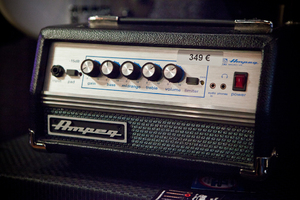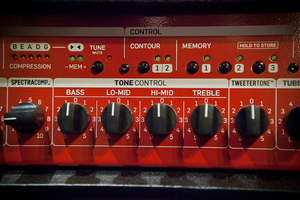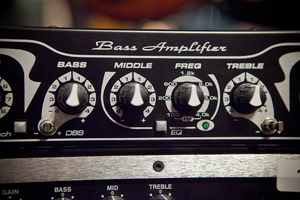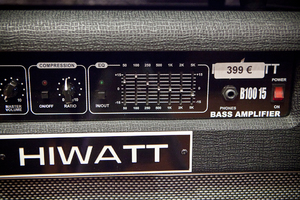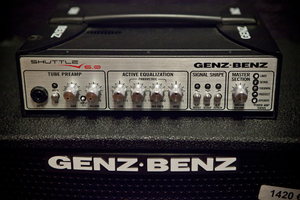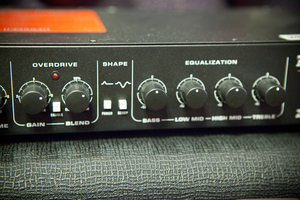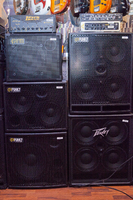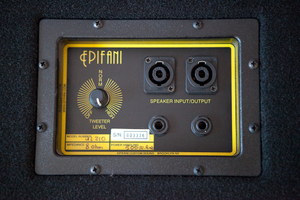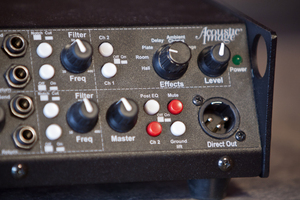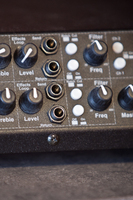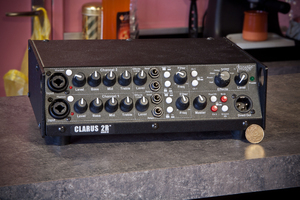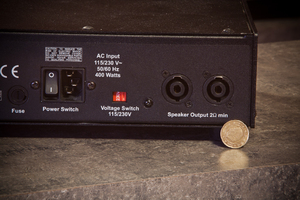I read somewhere that Leo Fender’s genius was in his business choices. He was one of the first to understand that the success of an electronic instrument depended on the quality of its amplification. He then put out a new amp to go with every new guitar. Without the Bassman, the Precision would have taken a lot more time to become successful! That’s why we’re following up our recent bass buyer's guide, with a new guide, this time for bass amplifiers.
Watt for ?
Not too long ago, you bought your first bass and a little combo amp to go along with it to play at home. You practiced a lot, but now it’s time. You have to prove yourself, you’re in a band! Finally, people are going to hear you play! You’re going to be able to put all those practice hours to good use, and you’re gonna need a powerful bass amp to put your otherworldly talent on display. Now depending on your geographical location, there are two possible scenarios: either you’re a city dweller who lives in an apartment, as do your band mates. Since the grandma upstairs has heart problems and the ex-boxer downstairs is not too keen on loud music, you have given up the idea of practicing at your place. Therefore, you have to rent studio space to practice. Or, if you’re lucky, at least one member of the band lives in the country with a house and a large garage or basement and you all move in for the duration.
Well, dear bass players, I’m afraid to tell you that in either case you’re going to need an amp with a little more guts than the 20 watts you currently own. In the first case you’ll need it for stage work; in the second case you’ll need for both practice sessions and shows. Yep, you’re going to have to dig into the piggy bank! But I’d rather use the term “investment” and will even try to steer you towards a good deal. Let’s begin with a bit of practical advice that’ll allow you to invest wisely and logically.
So Watt ?
I’ll start by reminding you of some amplification basics concerning your particular instrument. This is very important, since it is the last link in the sound production chain before reaching the public’s precious ears (and yours)!
How does an amplifier work? Schematically, it’s comprised of three distinct elements:
|
Standard 3-band equalizer |
The preamp: It receives the electric signal from the bass (very low in intensity and very high in impedance) and adapts it before handing it over to the power stage. In fact one could consider it as a first power stage. It contains a gain and a more or less sophisticated equalizer which, when required, corrects instrument « grain » by modifying its frequencies. For this, we use equalizer bands that allow us to increase or cut off frequency sets. There are three types of bands: bass, medium (mid) and high.
Sometimes you can have a double band for the mediums (low mids and high mids), a semi-parametric EQ which is always dedicated to mediums (frequency sweep and level), or even a graphic interface to tackle these frequencies.
| 4-band equalizer |
Semi-parametric with |
| Graphic equalizer |
Some preamps give their users the ability to use “shortcuts”, filters and boosts, with a simple switch which boosts or cuts off the gain for dedicated frequencies: bass (boost), mediums (contour) and highs (boost).
| On the right, just before the Master, the “Shape” Control |
Lastly, as is the case with guitar-dedicated preamps, ours sometimes have multiple stages which allow for color and signal distortion using a circuit with specific components, like preamp tubes (12Ax7, ECC83, ECC82…) or tube simulation. You can choose one channel or another and, in some cases, mix them both.
| 2-channel preamp |
Saturation can also pass through the signal via a second gain, pushing it to the max.
| Preamp with saturation stage |
Amplifier: Its role is simple: to amplify the signal for the speakers. Since 1975, thanks to an initiative from Marshall, amplifiers possess an additional gain from that of the preamp. We call it the Master, or overall volume. It gives us the advantage of managing output levels for both stages simultaneously and obtaining a saturated sound, without increasing the master volume.
There are several bass amp operating classes. In order to enlighten you without repeating myself, you can read the chapter dedicated to this information in our preceding review. The amp generates an electrical power which is noted in watts. This power will, for the most part, manage overall maximum volume.
Along with the different amp classes, components generating power can vary. From tubes to solid-state (classic or MOSFET), manufacturers propose several solutions for arguably better performance and/or price.
Finally, we bass player can also opt for a bi-amplification system. This doesn’t mean the thing is open to interpretation, just that the output signal is split in two parts (high and low frequencies) thanks to a crossover filter which sends the frequencies to different speakers. In this way, a musician can send highs or lows to a different speaker depending on the sound they wish to achieve. We’ll take a look at the sound characteristics of some typical settings available on the market, a little later on.
Cabinet: also called a “cab”, it constitutes the last link in your sound chain. It’s made up of one or more speakers with a consolidated cabinet (usually plywood). Speakers come in several sizes, generally from 8 to 18 inches, the 15", 10" and 12" models usually being used by us bass players. Their role is to produce the sound from the electronic signal coming from your amp, via a simple procedure: a magnet serving as a continuous magnetic field generator, which triggers a copper coil in relationship to the voltage received. Since this coil is attached to a membrane, its movement brings about a vibration, producing a sound.
|
On the right, two versions of a 4X10 inch, on the left from bottom to top, a 15”, a 2X10 and a 12" |
The larger the diameter of the speaker, the larger the vibration surface (the membrane) and therefore, better bass frequencies. We consider the 15" speaker as a woofer (speaker for bass frequencies), 10" and 12" for mediums and less than 10" for the highs. Another type of speaker specialized in high frequency reproduction and usually found up front, is the “tweeter” (not to be confused with that bloody blue bird). There are cone tweeters (smaller), dome tweeters, (the membrane is replaced with a solid material) and piezo-electric tweeters (quartz or barium which size changes depending on the voltage that runs through it, these variations trigger a membrane in order to produce the sound).
Speaker choice is not limited to size, but also to design: from magnets to membrane; every component can change the sound.
|
Connections for a 2X10 with tweeter volume control |
In the beginning our cabs only had a large 15" woofer mostly for the low frequencies, but manufacturers soon proposed larger units with multiple speakers. Fender came out with the first bass amp equipped with four 10" speakers (commonly a 4×10) barely two years after the first Bassman, in 1954. Since then, this type of cab has generalized. You can find it in just about every manufacturer’s catalogue with a 2×10 (two 10" speakers), the traditional 1×15 (one 15" speaker) and sometimes 1×12 or 2×12. Finally, the cab adjustments and the speaker position are also just as important for good spreading, for it does not just support the speakers. Its main role is to direct the sound waves, first up front and most importantly within the cabinet itself. A speaker also produces a sound wave towards the back and it’s very important that this wave does not interfere with the one sent to the front. The cab volume absorbs this wave which results in an acoustic pressure (to sum up, the air displacement). This is managed with internal panels and acoustic wool. A trick for bass amps, which must maintain correct volume and low frequency range is the Bass reflex cab. The principle is simple, the acoustic pressure is sent to the front via one or more air vents (usually found at the bottom of the cab, away from the speaker). That’s the reason why one sees those large openings on bass cabinets.
But they are not cat flaps, wether your favorite pet likes it or not…
To sum up, the preamp defines the signal, the amp supplies the power, and the speaker sends the sound out to the public.
The preamp, power amp, and speaker cabinet can be purchased in combination, this called a “combo”. You can also buy an amp/preamp head separate from the cabinet, called a “stack”. Some manufacturers even have separate preamps and amps.
Combo or Stack?
Now we’re talking! Let’s take a look at some the advantages and disadvantages of each system.
The Combo: all in one, it’s definitely a practical solution which saves space, logistics and connections. Just turn it on, plug in the bass, turn up the volume and play. The market for combos nowadays has many speaker configurations available, a large choice of preamps and power amps going up to 750 watts! But in my humble opinion one doesn’t choose a combo for its power. There are stacks that offer higher performance at those higher volumes. The choice of a combo is based on price, size and practicality. Up to 300 watts will suit most of the bass players. Over that, a combo has its limitations due the format and our instrument (remember all that sound wave, acoustic pressure, etc.). When there’s less room, air circulates with more difficulty and that hinders speaker performance. High-end powerful combos can remedy this issue (connecting a second cab, multiple poles for increased diffusion), but they also come into competition with the stack market.
|
Example of a switch-mode power supply with heat reducer |
The Stack: stacks eliminate a lot of the aforementioned room problems. The amp head is separated from the speakers so the cabinet has more room. The vibration levels absorbed by the amp/pre-amp are also decreased for they are not attached to the speaker. But the main advantage is modularity. You can buy an amp head and change things around as needed. Unlike the combo, you can change the speaker or amp anytime you like.
Stacks propose higher power than combos and an alternative to buying a complete new system when your needs change. Some heads (Class D amps with switch-mode power supply) can even work without a speaker and so be used alone for recording. But watch out! In most cases the head has to be connected to a speaker or it will soon turn itself into a very expensive hot plate.
The setbacks? Price and size. Both are slightly higher than a combo.
There are, however, newer, smaller, lighter independent cabs with performances that are just as good. New technologies like the neodymium magnet, which are becoming more and more present in speakers today or isobaric speakers both offer solutions in this area.
How to choose?
Now that you have the basics (if you’re still reading) I’ll try to give you some advice on choosing your equipment. It’s hard for me to come up with an individual solution for each and every situation, plus this is not a commercial for any one particular brand or model. I’ll just provide some keys for the right investment. You’ll learn how to choose your amp according to the criteria described above. The hardest part is to assemble all the qualities in a single combo, if you choose this amplification solution, and you’ll still have to estimate the qualities of the individual elements in any case.
A good preamp
The preamp choice has to be left up to your taste. As a bass player you have a natural penchant for linear sounds (which best reproduce the natural grain of the instrument) with a little extra warmth. But some of us, like our guitar playing siblings, will look for a particular « color »: a rock or rounded sound, the typical distortion tone which, if needed, will pass through a tune stage. There are preamps which are more or less neutral and can have an impact on the overall sound “color”. You have to try out a maximum number of equipment to find out which one is meant for you. The best is to listen to the preamp signal without passing through the amp and speaker, by using a pair of headphones or a line output.
While we’re at it, let’s talk about built-in connections. Here is what one can find on a preamp stage, and can be very useful:
– Jack In: this is where you plug the bass in. This input can sometimes be doubled in order to allow for two instruments (one active, one passive), it can also be single with a gain switch which lower the input gain by 10 decibels (for active bass). Why, you ask? Simply to reduce the gain difference between the two types of electronics found in bass guitars.
- Headphone Out (mini-jack): very practical on home stereo amps but rare on larger systems which are not really suited for this kind of use.
- Aux In (mini-jack or RCA): lets you plug in an external source (player, computer, etc.) for practice purposes. Like with headphones, it’s rarely found on stage amps. But it does exist, especially with the 100 watt amps.
|
Details of Direct Out with post EQ and Ground/lift |
– Line out (jack): unbalanced (which usually doesn’t pass through the EQ or the preamp), it allows you to send a signal to another amp in order to extend your diffusion range.
– Direct out (XLR): Lets you send a balanced signal to a mixing console or recorder. Very useful in studio and on stage. Often bundled with two switches (Ground/lift and post Eq) which do away with ground loops* and bypass the preamp EQ to use the mixer EQ.
– Effects Loop (two jacks): lets you assemble effects in parallel to modulate their level on the signal and, especially, place the effects chain after the EQ. When plugging your pedals in between the instrument and the amp, this is called ‘in series”, and the EQ corrects the signal modified by the effect. Moreover, the sound signal from your instrument having to pass through your pedals, will then be modified. This is the reason why the True Bypass concept was invented, which, unfortunately, isn’t included in all pedals.
|
Effect Loop details, (doubled here) |
That’s it for the preamp connections. You’ll notice however that all the manufacturers do not offer all theses connections. You have to decide which ones you’ll need the most. As far as preamp adjustments go, beginning with the EQ, the market is varied. Manufacturers do not all have the same philosophy when it comes to this point. Some of them only have 3-band EQ, others have semi-parametric, while still others use graphic EQ. My advice would be to let you decide which one feels right for you. As for me, I like to keep things simple: a low band, a medium band and a high band, and I’ll do the rest myself. Now, every once and a while I need to « push » a little on the mediums, and when that happens it’s nice to have a semi-parametric at hand (actually I can do without). For all my rock bass player friends who like saturation, I would recommend you make sure that the amp has an additional gain or better yet a second stage dedicated to the purpose with, why not, one or two tubes to give your sound some guts.
Preamp tubes can also be used to add some harmonics to the distortion, but be careful, do not mix up signal distortion with saturation. In this present case, the sound will remain clear, but the signal will be colored by the tubes.
Power?
| Benefits of Class D coupled to a switch-mode power supply: miniature amp, here a 400W RMS amp head! |
Just choose to your liking. To start playing in a band, we recommend not to go below 80 watts. As for me, I can only advise you foresee higher power so that you’ll always have a bit of a reserve in the tank and not continually be playing “maxed out”. A 150 to 200 watt amp seems, to me, a good starting point. You’ll be ready for most eventualities and your investment will last longer.
Along with the power choice, you’ll also have to consider size and weight. The power supply in an amp head is the heaviest and the biggest component. Nowadays you can find switch-mode power supplies, which considerably reduce format and weight problems. I use one myself and I love being able to slide my 400 watt amp into my bass gig bag. It’s not rare, nowadays, to see miniaturized versions with quality bass sounds, using class D amps. So jump in. They’re made for basses!
| Speaker outputs with 2 Ohm impedance minimum on an amp head. It requires two 4 Ohm cabs to reach full power. |
On some combos and globally on amp heads, you’ll find power level thresholds (in watts) depending on its impedance (in Ohms). Since I hate paraphrasing others and documentation on this subject is abundant, I’ll let you read all about it in an article by Doktor Sven : An Ohm Story.
About All-Tube Amps
Some of you are probably tube freaks or nostalgic addicts of the vintage sound of the first SVT, the '59 Fender Bassman or the mythical DR201 from Hiwatt. They might sound great but be aware that the price is not for everyone and using some of them requires some precautions: warm up time, cool down time, caution during transport, tube maintenance. Personally, I’m not in love with tubes. I’m not against them, of course, I just find that transistor technology can provide the same warm grain without the logistical setbacks. Current hybrid system alternatives (tubes for preamps and solid-state amps) let you play on both sides of the game. I would advise, as a first buy, a solid-state or hybrid system.
Choosing your cab
If you opt for the combo, you’ll only have to choose the right configuration among the ones the manufacturer has to offer. The onboard speaker(s) in the combo are designed to work with the built-in power amp. Though it is necessary in a stack, a speaker can also add to your combo output if the latter has an extra output jack. Combos with this jack usually don’t peak out until there is actually another speaker cab hooked up to it. When purchasing a cab it is very important to respect the load and impedance criteria. Since I know you readers are diligent students, I’ll assume you have read the aforementioned article by Doktor Sven.
I’d like to mention here that a good speaker can help a not so good amp achieve your dream sound.
Don’t try to save money at this point. Don’t buy the first one you find. Shop around! I’ll just advise on the sound specifications you’ll be coming across in your search, and which can be found in every manufacturer catalogue.
1X15 inches: this is the reference, offering a large woofer for ideal bass sounds. The 1X15 inch may be considered as the bass amplification genesis and though rudimentary, it still works today. Numerous bassists will play exclusively on this configuration and in this regard, many manufacturers have added a tweeter to help out with the highs. Remember, a 15-inch woofer is great for producing wide vibrations for the low-end but it doesn’t do much regarding the response time due to the vibration amplitude. That’s why I recommend using a 15-inch speaker as an addition, especially if the musician in question is a ‘percussive’ type player. I am an unconditional fan of the association of a 1X15 coupled with a 2X10.
2X10 inches: perfect for producing nice mediums, achieving over the top highs, ensuring slap players with an effective response and adding bite when using a pick. Cabs with two 10" speakers are also appreciated for their smaller size. They can be used on their own for their ergonomics and sound color, favoring dynamics over bottom end. But they’ll achieve their best when complementing a 15" speaker. Having both will allow you to adapt to different situations. Used alone, they adhere to a certain style of music. Together they ensure large sound diffusion within their frequency range.
4X10 inches: A good amplified rendition of your instrument bass frequencies is definitely needed but the capacity of a cab to reproduce impulse is also very important. If you listen to a bass line, you notice that musicians in general don’t pass their time just play whole notes. On the contrary, we try very hard to stick to the kick (bass drum). The 4X10 was developed over the course of time to ensure correct bass reproduction while adding good response time. To do so, we use 4 smaller speakers and it’s been working for years.
As opposed to the 1X15 and 2X10, I consider the 4X10 as the best solution for solo diffusion along with the 2X12. A good speaker in this category ensures on its own overall bass frequency diffusion as well as response time and power requirements. It’s the Swiss army knife of the bass amps which works great alongside a 15’’ woofer.
2X12 inches: My favorite. Not big but offers great dynamics and bandwidth. It goes way down deep into the bass frequencies but keeps accurate mediums and highs. It does, however, have two setbacks: it doesn’t really go well with a 1X15 or a 2X10 and it’s a rare market item these days.
To illustrate this comparison, here is a table showing the sound characteristics of the Pro Line Series from EBS. You’ll find the different bandwidth per speaker type.
|
EBS PROLINE |
Proline 212 |
|||
|
Bandwidth |
35 Hz to 3KHz |
70 Hz to |
70 Hz to |
30 Hz to |
|
Sensitivity |
103 dB |
100 dB |
103 dB |
99 dB |
And some sound examples of these four speaker types:

- 8×1000:19
- 1×1500:19
- 2×1000:19
- 1×15+2×1000:19
- 2×1200:19
- 4×1000:19
Watt else?
Here is a recap:
Purchasing a Combo:
– Think about having enough power, it will be difficult to add after purchasing.
– Keep gadgets out of the loop. Accessories like effects, DSP processors, simulation, tuners, etc., can be handy but shouldn’t get in the way of the essentials: quality sound and output level.
– Its size and weight must be practical; this is the best feature for a combo.
– Choose the speakers well according to your style.
– Run away from any undesirable distortion. If a Combo distorts at medium volume in the shop… forget it.
– Look at the built-in connections. You might someday need an external effect or a DI.
– If the combo is powerful (more than 200 watts) check before buying that this won’t be done at the expense of a second speaker in the future. It will cost you more later on.
– Consider the quality of each element separately (preamp, amp, cab) before appreciating the overall quality.
– Front face adjustments should be easy to read as well as easily accessible. Stages can sometimes be dark. Lighting can be strange and you may need to make some adjustments quickly.
– If the combo is large, consider the transportation issues (added wheels, telescopic arm and other transportation might save you a backache)
Purchasing a Stack:
– Don’t skimp on the price of speakers, a great amp head is good but diffusion is a priority.
– Don’t hesitate to mix up the brands; this is one of the advantages of a stack.
-When selecting speakers, look carefully at the power and impedance rates. The golden rule is to never go below the minimum impedance of the amp head (amp impedance will be noted somewhere, probably on the rear) and use speakers that will handle more power than the amp will provide. If the speaker impedance is lower than the one on the amp head, your amp will soon serve as a space heater before sending up a nice plume of white smoke to announce the arrival of the new Pope. If you send too much power to the cab, it will cause irreversible damage to your speakers.
– Always try out speakers on your own amp head or an identical model before purchasing.
– If you would like more than one speaker, make sure they match, especially with frequency response.
– Think about cable budget, an amp head connects with speaker cables. You need a quality cable to ensure electronic safety. Remember that electricity is passing between your amp and cab, not sound…
– A cab with removable wheels (keeps the doctor away) is very handy, if not foresee a dolly of some kind (preferably a staircase type) or a roady buddy.
In both cases, I would advise you to avoid all kind of strong opinions or bias. You have to try out a lot of amps before deciding. All the feedback from your friends and online forums are fine, but nothing is more valuable than your own ear and judgment.
Only you can know for what’s good for you and remember that we don’t all hear a sound the same way. Sound perception is a very personal thing; don’t buy an amp because your friend likes it. Buy it because you tried it and took the time to appreciate its intrinsic qualities. Take your time. Make sure you’re convinced before breaking out the credit card. Good hunting!!!

